Happy Friday, GPODers!
On May 13 I had the pleasure of visiting the New York Botanical Garden in the Bronx, N.Y., to conduct an interview with a researcher for an upcoming article and to attend a dinner held by Bailey Nurseries. While the trip was planned with high hopes of sunny weather, which would allow me to explore every inch of the garden and inspect as many blooms as possible, the reliably turbulent spring weather of the Northeast gave us a day of rain. Despite the dreary skies and precipitation, I was still able to enjoy a small chunk of the garden and capture some colorful highlights.
Thanks to a small covered seating area in the Native Plant Garden, we were still able to conduct our interview outside and enjoy the sights and sounds of this serene space. While this garden was in between peak bloom periods, there were several pops of color still sprinkled throughout, and the entire area was alive with bird sounds.
 Early spring ephemerals in the garden had already faded, but longer-lasting spring blooms like this eastern bluestar (Amsonia tabernaemontana, Zones 3–9) were still putting on a lovely display along the paths. A bright green sensitive fern (Onoclea sensibilis, Zones 4–8) made for a perfect companion to the ice-blue blooms.
Early spring ephemerals in the garden had already faded, but longer-lasting spring blooms like this eastern bluestar (Amsonia tabernaemontana, Zones 3–9) were still putting on a lovely display along the paths. A bright green sensitive fern (Onoclea sensibilis, Zones 4–8) made for a perfect companion to the ice-blue blooms.
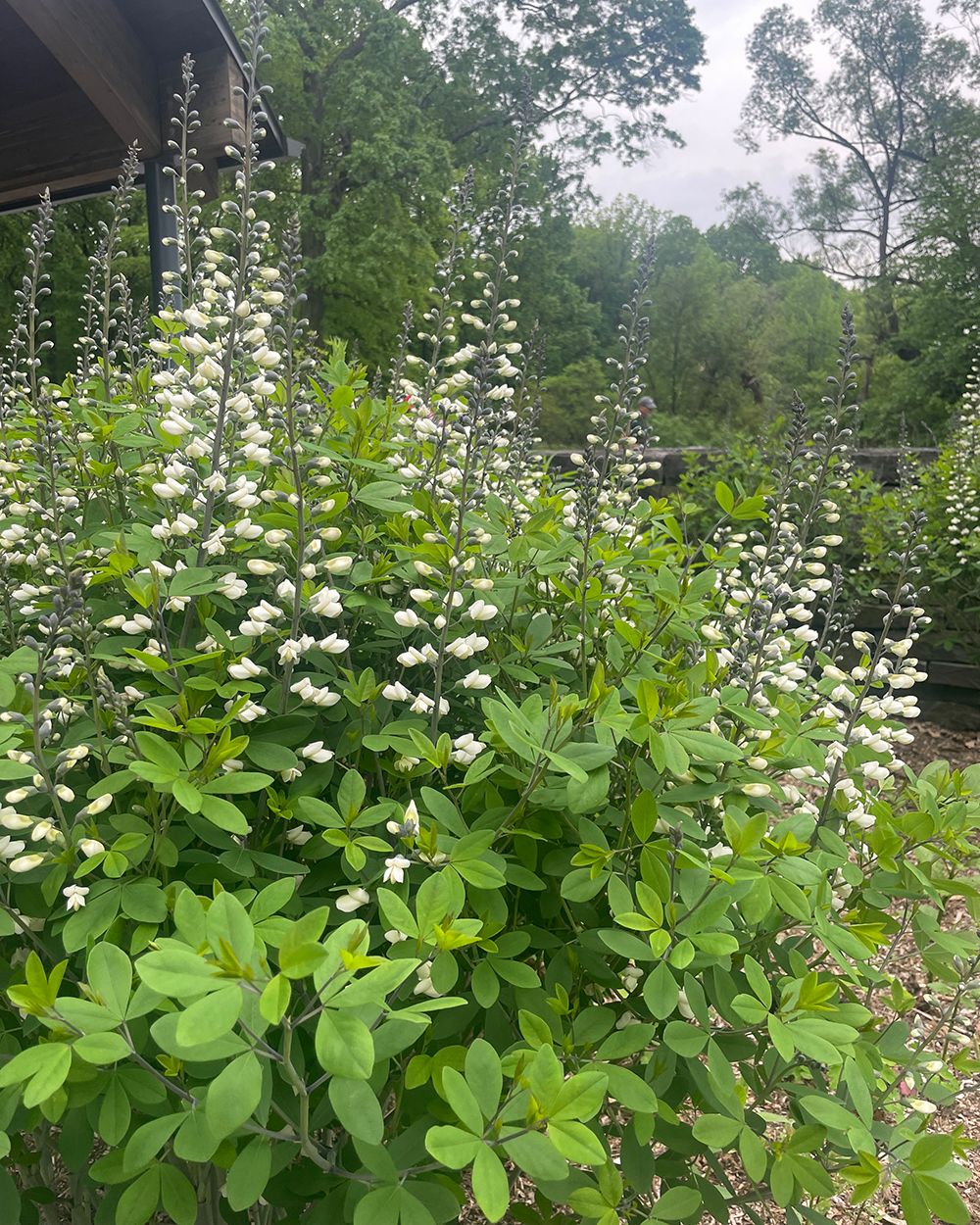 At the entrance of the garden, the deep purple-blue stems of these massive white false indigo (Baptisia alba, Zones 5–8) were already covered in creamy white blooms, putting on a bit of an early show for us.
At the entrance of the garden, the deep purple-blue stems of these massive white false indigo (Baptisia alba, Zones 5–8) were already covered in creamy white blooms, putting on a bit of an early show for us.
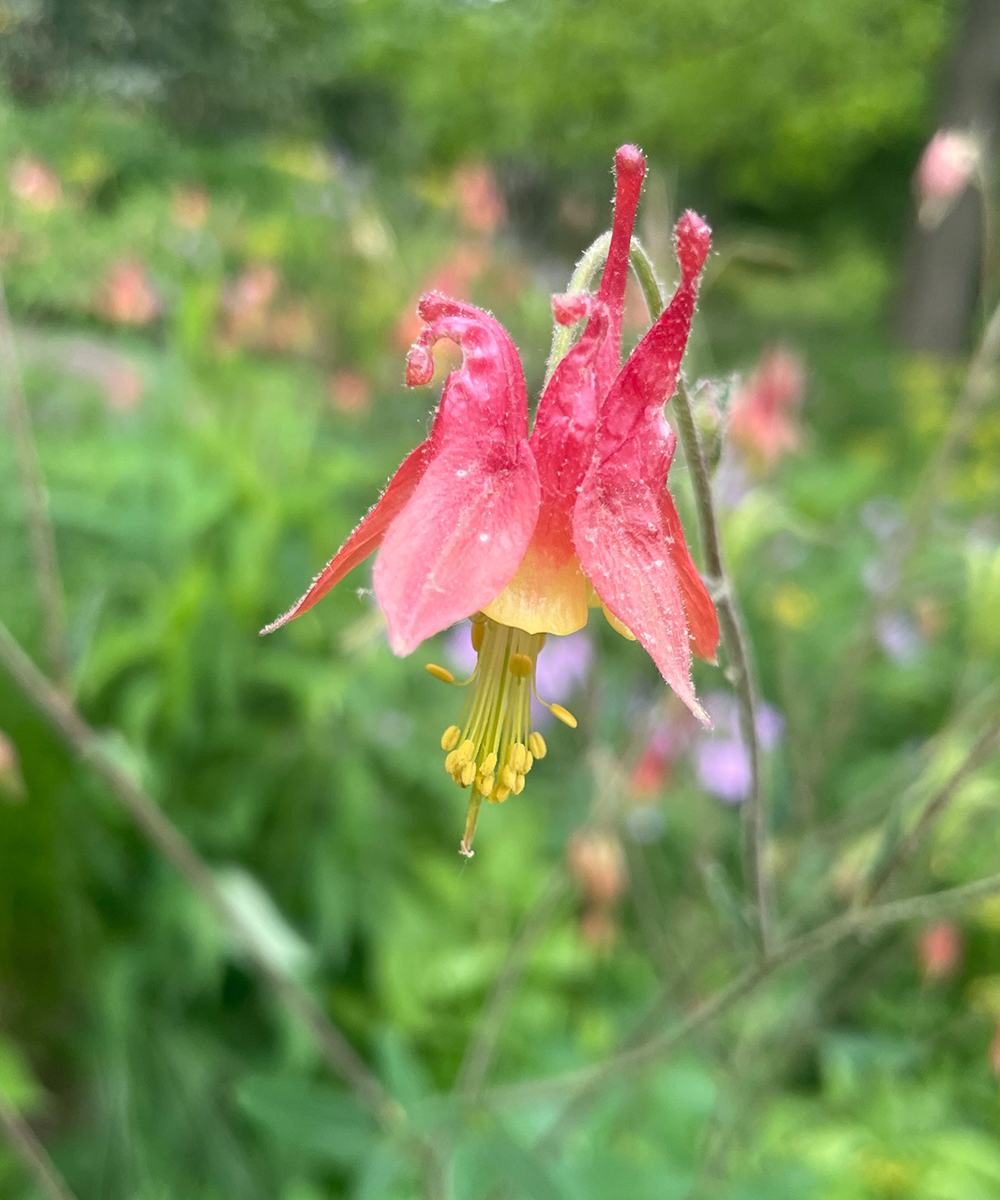 And we likely caught the tail end of this Eastern red columbine’s (Aquilegia canadensis, Zones 3–8) floral performance for the year.
And we likely caught the tail end of this Eastern red columbine’s (Aquilegia canadensis, Zones 3–8) floral performance for the year.
Few other public garden spaces I’ve visited have felt as immersive as the Native Plant Garden. Lush foliage envelops you from all sides, and the sounds of small wildlife can be heard scurrying among the plants. If you keep your eyes and ears open, you might capture something magical. After just a few minutes wandering the paths around the long garden pool, I spotted this American robin (Turdus migratorius) enjoying a little bath on these large boulders.
 While flowers were limited in the Native Plant Garden, they flourished elsewhere. At the main entrance, these pretty pots were a vision in yellow, with cherry pansies mixing with golden variegated sweet flag (Acorus gramineus ‘Ogon’, Zones 5–9).
While flowers were limited in the Native Plant Garden, they flourished elsewhere. At the main entrance, these pretty pots were a vision in yellow, with cherry pansies mixing with golden variegated sweet flag (Acorus gramineus ‘Ogon’, Zones 5–9).
 This photo of the Enid A. Haupt Conservatory—a true architectural marvel to see in person—really captured the grayness of the day. However, the overcast skies have a way of making the flowers that much brighter, and this winding path in front of the conservatory was glowing with early sunflowers.
This photo of the Enid A. Haupt Conservatory—a true architectural marvel to see in person—really captured the grayness of the day. However, the overcast skies have a way of making the flowers that much brighter, and this winding path in front of the conservatory was glowing with early sunflowers.
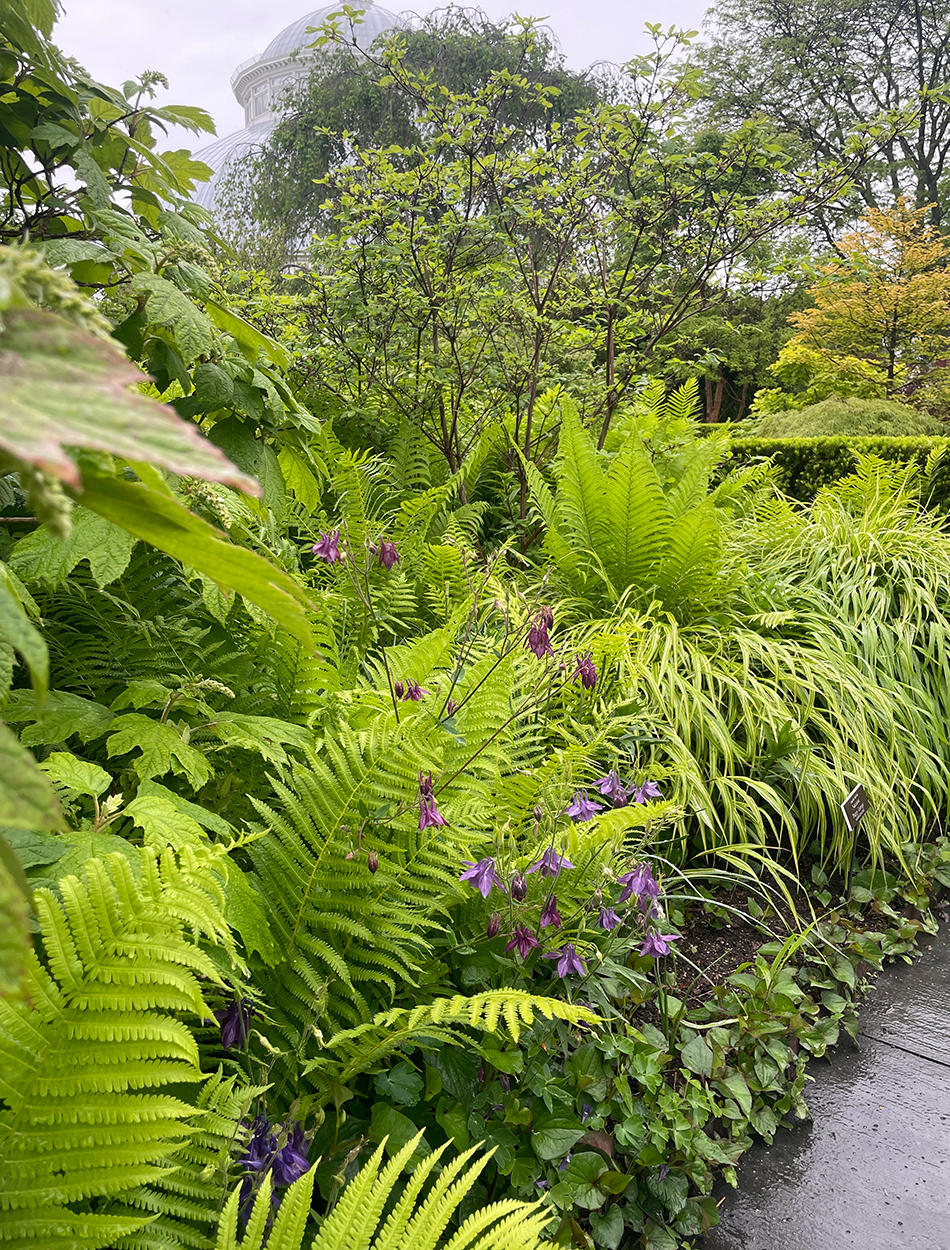 Past the winding path of sunflowers, on the opposite side of the conservatory, the Perennial Garden had lots of blooms and incredibly bold foliage to enjoy. My eyes gravitated to this bright bed of chartreuse ferns and grasses. A splash of purple columbine is the perfect accent.
Past the winding path of sunflowers, on the opposite side of the conservatory, the Perennial Garden had lots of blooms and incredibly bold foliage to enjoy. My eyes gravitated to this bright bed of chartreuse ferns and grasses. A splash of purple columbine is the perfect accent.
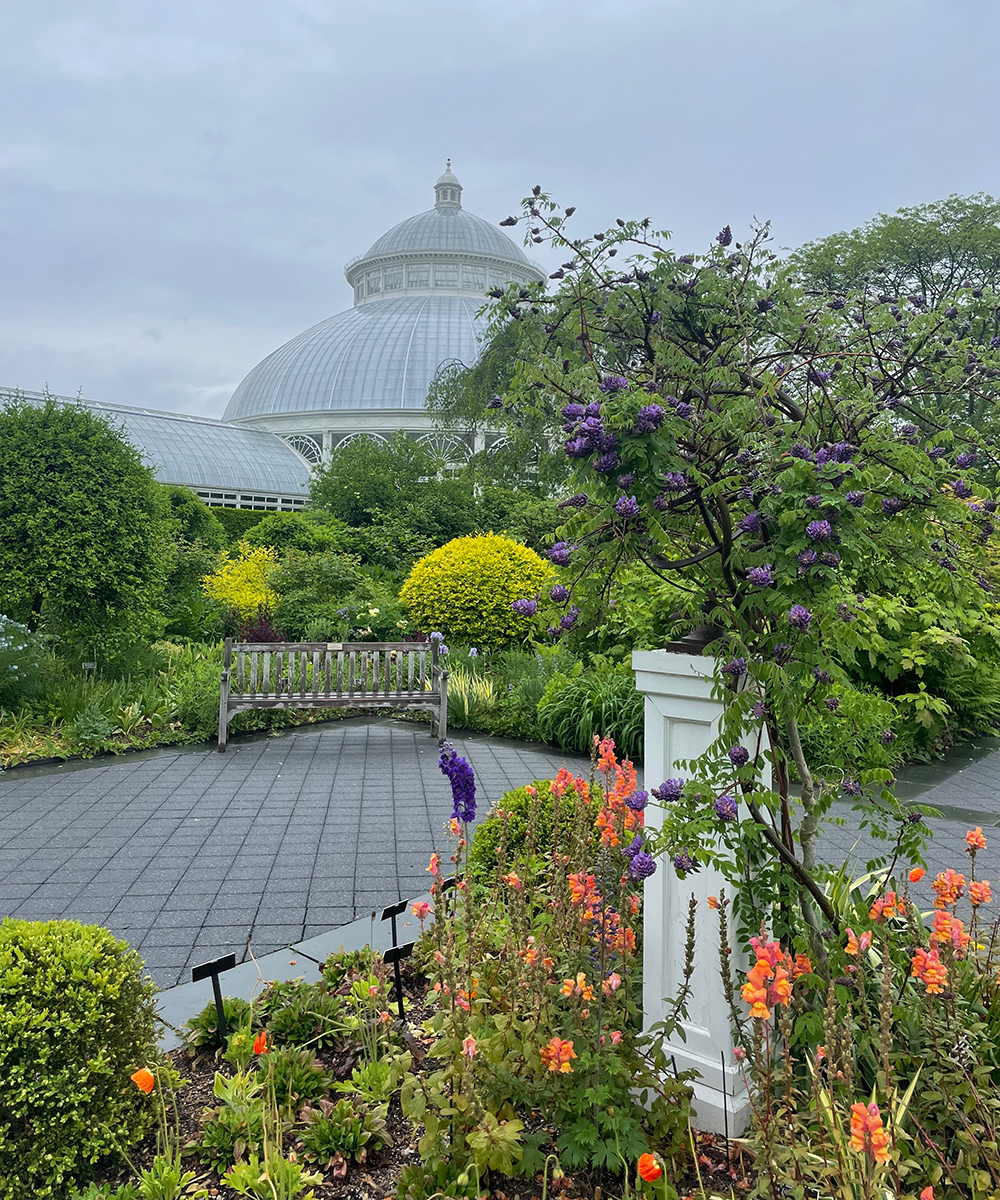 Opposite this planting, an ‘Amethyst Falls’ American wisteria (Wisteria frutescens ‘Amethyst Falls’, Zones 5–9) looked extra regal with a bright white column as its support. While often not as floriferous, American wisteria is always a better option than its highly invasive relative Chinese wisteria (W. sinensis, Zones 5–8), and ‘Amethyst Falls’ is a great cultivar.
Opposite this planting, an ‘Amethyst Falls’ American wisteria (Wisteria frutescens ‘Amethyst Falls’, Zones 5–9) looked extra regal with a bright white column as its support. While often not as floriferous, American wisteria is always a better option than its highly invasive relative Chinese wisteria (W. sinensis, Zones 5–8), and ‘Amethyst Falls’ is a great cultivar.
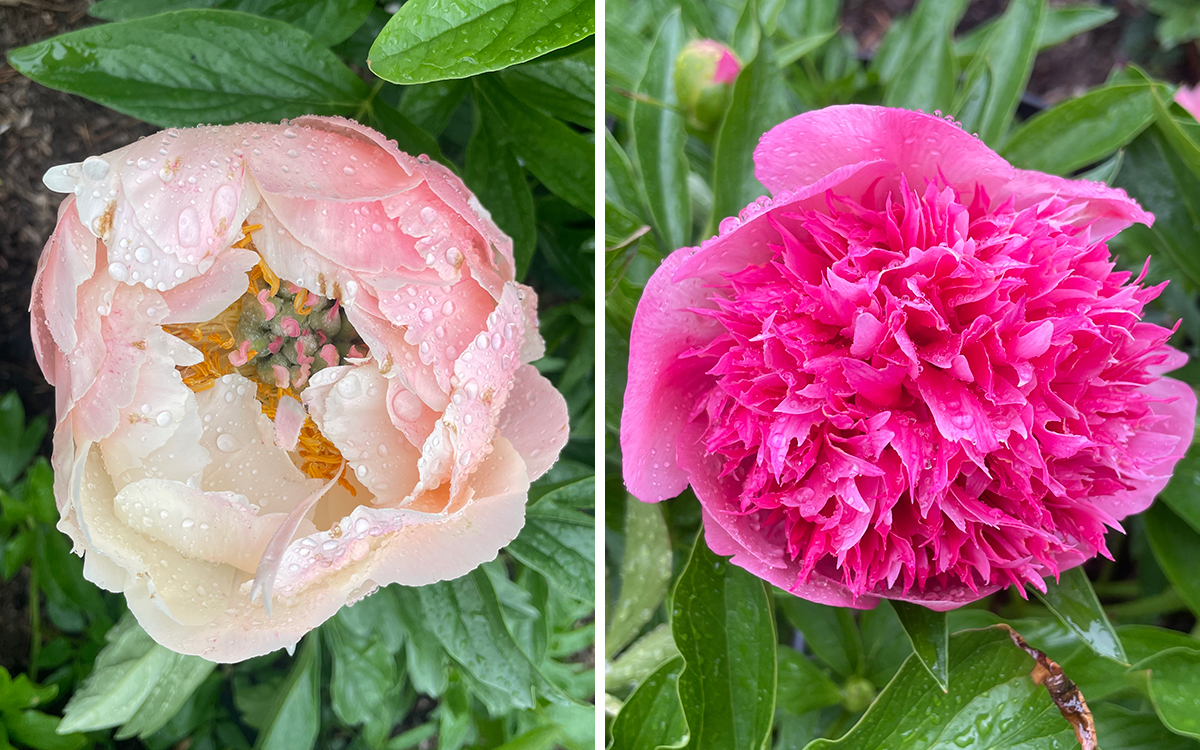 Across from the Perennial Garden, various peonies were just starting to perform. Many plants were covered in blooms not quite ready to burst, and the earliest blooms on select plants were just unfurling. ‘Coral Supreme’ (left) and ‘Salmon Glow’ (right) (Paeonia ‘Coral Supreme’ and ‘Salmon Glow’, Zones 5–9) were two particularly spectacular early bloomers.
Across from the Perennial Garden, various peonies were just starting to perform. Many plants were covered in blooms not quite ready to burst, and the earliest blooms on select plants were just unfurling. ‘Coral Supreme’ (left) and ‘Salmon Glow’ (right) (Paeonia ‘Coral Supreme’ and ‘Salmon Glow’, Zones 5–9) were two particularly spectacular early bloomers.
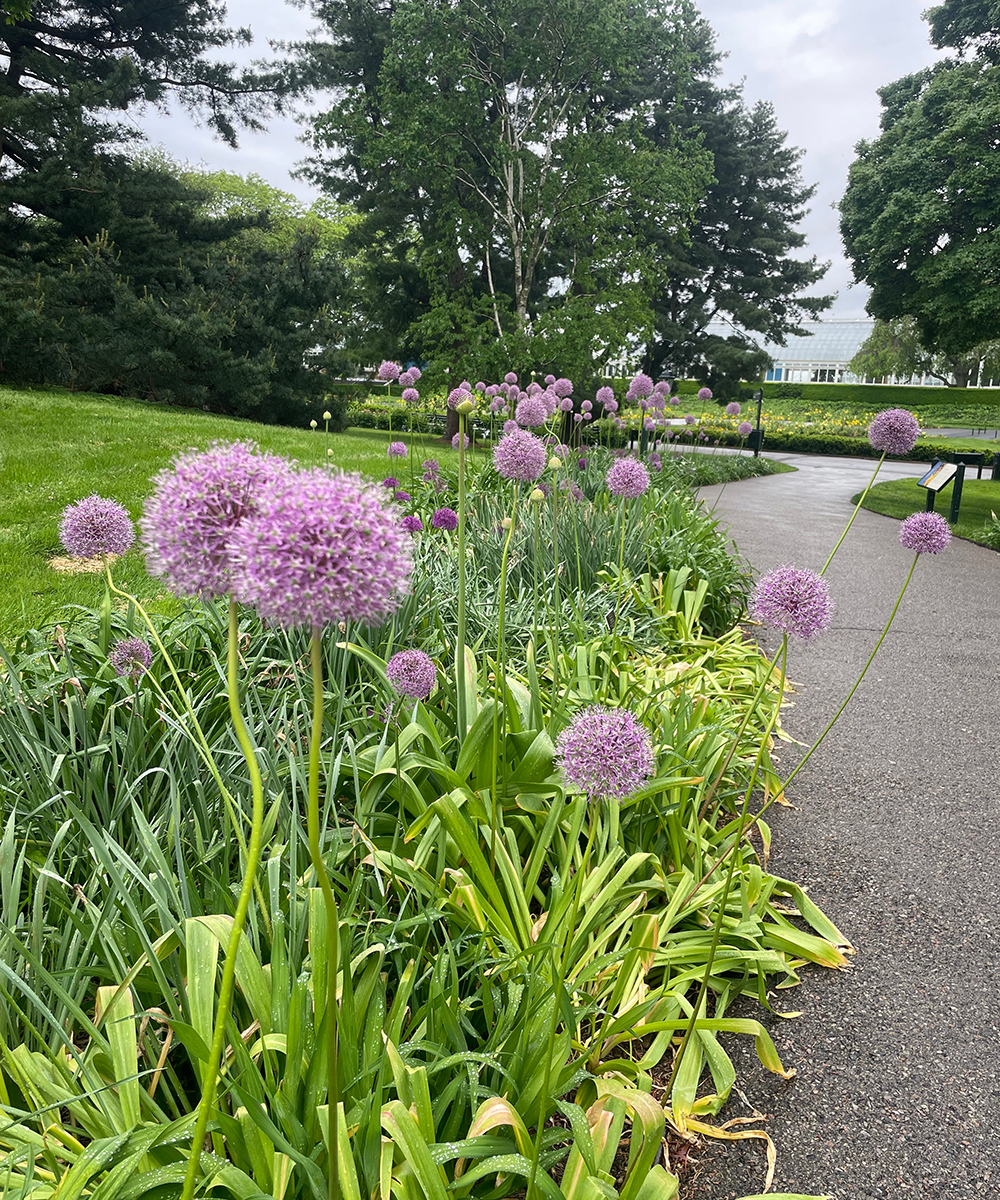 Following the path of the peonies, you’ll come across another path that leads you toward the Conifer Arboretum. One of NYBG’s earliest collections, there are some seriously impressive conifers in this garden that date back to the early 1900s. However, we didn’t get very far into this garden before we were distracted by an incredible border of allium blooms.
Following the path of the peonies, you’ll come across another path that leads you toward the Conifer Arboretum. One of NYBG’s earliest collections, there are some seriously impressive conifers in this garden that date back to the early 1900s. However, we didn’t get very far into this garden before we were distracted by an incredible border of allium blooms.
 Outside the Hudson Garden Grill, where the dinner was held at NYBG, various containers were potted with the prettiest combinations. Unfortunately, the rain was coming down hard and the dinner had to move inside, so we didn’t get to enjoy these containers throughout the evening. Though maybe it was for the best—I likely would have been too distracted by these gorgeous plantings to make good conversation.
Outside the Hudson Garden Grill, where the dinner was held at NYBG, various containers were potted with the prettiest combinations. Unfortunately, the rain was coming down hard and the dinner had to move inside, so we didn’t get to enjoy these containers throughout the evening. Though maybe it was for the best—I likely would have been too distracted by these gorgeous plantings to make good conversation.
I hope you enjoyed these highlights from my trip to NYBG! If you can handle the rain, I highly suggest visiting a botanical garden during less than ideal weather. While the skies were gloomy, the pathways were open and empty to enjoy the gardens for as long as time allowed.
Have you visited any public garden this spring? Whether you’ve traveled near or far to see some spectacular spring displays, we’d love to see highlights from your trip! Follow the directions below to submit photos via email, or send me a DM on Instagram: @agirlherdogandtheroad.
We want to see YOUR garden!
Have photos to share? We’d love to see your garden, a particular collection of plants you love, or a wonderful garden you had the chance to visit!
To submit, send 5–10 photos to [email protected] along with some information about the plants in the pictures and where you took the photos. We’d love to hear where you are located, how long you’ve been gardening, successes you are proud of, failures you learned from, hopes for the future, favorite plants, or funny stories from your garden.
Have a mobile phone? Tag your photos on Facebook, Instagram or Twitter with #FineGardening!
Do you receive the GPOD by email yet? Sign up here
Fine Gardening Recommended Products

Wagner’s 52003 Classic Blend Wild Bird Food, 6-Pound Bag
Fine Gardening receives a commission for items purchased through links on this site, including Amazon Associates and other affiliate advertising programs.
Classic wild bird food uses the highest quality grains to attract backyard wild Birds. A high-quality mix containing Millet, milo, cracked corn and Sunflower for a wide range of wild birds to enjoy. Perfect for tube, hopper, or platform feeders. Great to feed in all seasons! Perfect for the winter, when seeds are scarce; spring and summer for hatchlings; and autumn to give energy to migrating birds. This seed will help you fill your yard with birds such as Jays, cardinals, doves, Juncos, finches, goosebeaks, any many more.
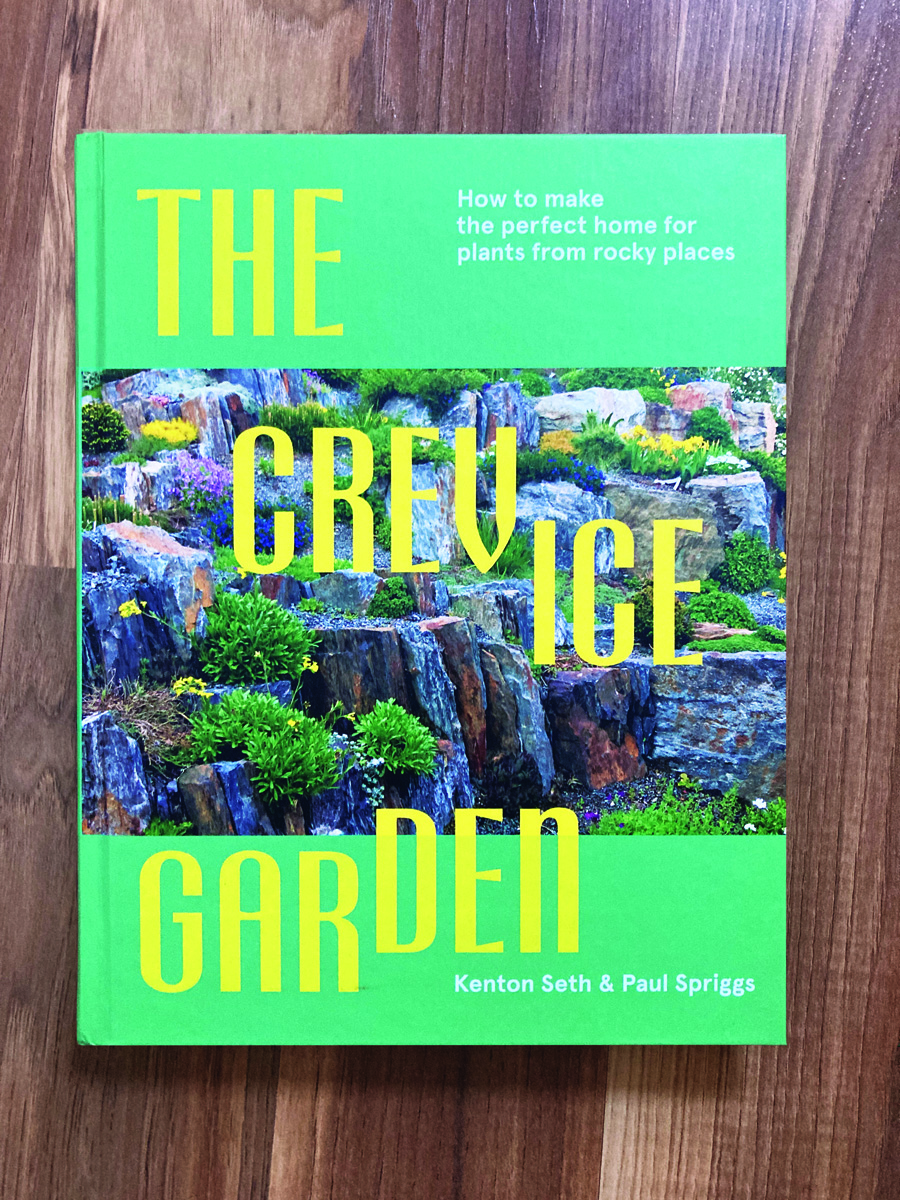
The Crevice Garden: How to make the perfect home for plants from rocky places
Fine Gardening receives a commission for items purchased through links on this site, including Amazon Associates and other affiliate advertising programs.
A crevice garden replicates the environmental conditions of mountain tops, deserts, coastlines, and other exposed or rocky places on earth. These striking garden features provide perfect conditions for the plants native to these far-off places, bringing the cultivation of these precious gems within everybody’s reach.

